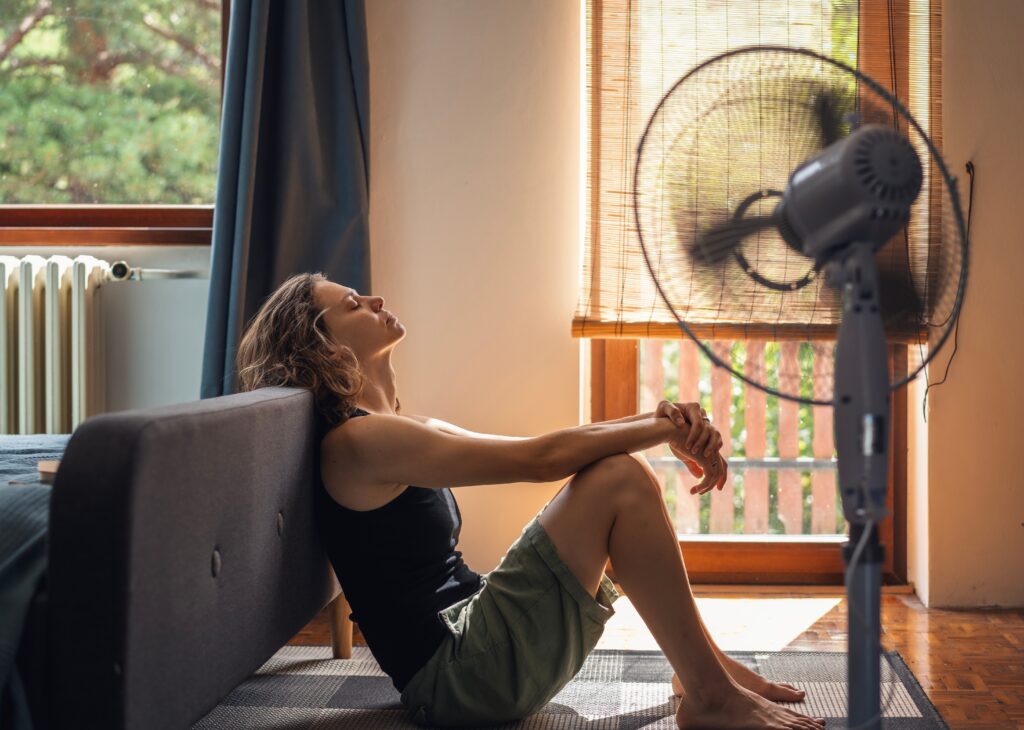Why Is My Upstairs So Hot? Top Reasons and Fixes

If the upstairs of your home feels like a sauna while the downstairs stays cool, you’re not alone. This common imbalance often points to deeper issues with airflow, insulation, or your HVAC setup. And while it’s easy to blame the sun or summer heat, the real culprits are often hidden in your attic or ductwork. Learning what’s behind the temperature difference is the first move toward a more balanced and efficient home.
Table of Contents
Common Reasons Your Upstairs Is So Hot
Heat naturally rises in homes due to basic physics, but several specific factors can make your upstairs unbearably hot.
1. Stack Effect (Heat Naturally Rises)
Heat rises in your home through a process called stack effect or thermal stratification. When indoor air warms, it becomes less dense and rises upward while cooler, denser air sinks to lower levels.
2. Poor Attic Insulation
Inadequate attic insulation allows heat from your roof to transfer directly to your upstairs living spaces. Your attic can reach temperatures of 150°F during summer, acting like a radiator above your ceiling.
According to Energy Star, homes with low insulation levels can have utility bills 10% higher than well-insulated homes. If your insulation is level with or below your attic floor joists, you likely need to add more.
3. Inadequate Attic Ventilation
Even with good insulation, your attic needs proper ventilation to release trapped heat. Without adequate airflow, heat builds up and transfers to rooms below.
Signs of poor attic ventilation include extremely hot attic temperatures, roof sheathing damage, and moisture buildup that can lead to mold growth.
4. Unbalanced HVAC System
Single HVAC systems often struggle to maintain consistent temperatures across multiple floors. By the time cooled air reaches upstairs vents, it may have lost much of its cooling power.
An HVAC system that’s too small, improperly installed, or poorly maintained will have difficulty cooling upper floors effectively.
5. Ductwork Issues
Leaky or poorly insulated ducts can lose 20-30% of conditioned air before it reaches its destination, according to Energy Star. This significant loss makes it especially hard to cool distant upstairs rooms.
6. Insufficient Return Vents Upstairs
Many homes lack adequate return vents on upper floors, creating a pressure imbalance that makes it difficult for the system to remove hot air. Without proper air circulation, heat becomes trapped in upstairs spaces.
7. Window Heat Gain
Windows, especially those with direct sun exposure, can allow substantial solar heat into upstairs rooms. Without proper treatments, afternoon sun can quickly turn bedrooms into hotboxes.
The Department of Energy estimates that up to 76% of sunlight that falls on standard double-pane windows enters the home as heat.
DIY Fixes to Cool Down Your Upstairs
Several affordable, do-it-yourself solutions can make a significant difference in upstairs temperatures.
1. Balance Your HVAC System
Adjust your HVAC dampers to direct more cool air to the second floor. This simple no-cost fix can dramatically improve upstairs cooling.
How to balance your system:
- Locate damper handles on main supply ducts
- Partially close dampers to downstairs areas (handles perpendicular to duct)
- Open dampers to upstairs completely (handles parallel to duct)
- Wait 24 hours to assess the difference
2. Use Ceiling Fans Strategically
Ceiling fans create a wind-chill effect that can make rooms feel 4-6°F cooler without changing the actual temperature. Ensure fans rotate counterclockwise in summer to push air downward.
The Department of Energy notes that using ceiling fans allows you to raise your thermostat setting by about 4°F without reducing comfort, resulting in significant energy savings.
3. Add Window Treatments
Thermal curtains, cellular shades, or reflective window film can dramatically reduce heat gain through windows. Keep curtains closed during the hottest parts of the day.
According to Consumer Reports, “medium-colored draperies with white plastic backings can reduce heat gain by 33 percent,” while reflective window films can block up to 70% of solar heat.
4. Change Air Filters Regularly
Dirty filters restrict airflow and reduce your system’s cooling efficiency. The EPA recommends checking filters monthly during heavy use seasons and replacing them at least quarterly.
5. Use Portable Cooling Solutions
For particularly hot rooms, consider window air conditioners or portable AC units. These provide targeted cooling without modifying your central system.
Cost range for supplemental cooling:
- Window AC units: $150-$500
- Portable AC units: $300-$700
Long-Term Solutions and Upgrades
These more substantial improvements provide lasting solutions to persistent upstairs heat problems.
1. Improve Attic Insulation
Adding proper insulation to your attic creates an effective thermal barrier. The Department of Energy recommends R-38 to R-60 insulation values for most attics.
According to HomeAdvisor, adding attic insulation costs between $1,700 to $2,100 on average but can reduce cooling costs by 10-50% depending on your current insulation levels.
Insulation options include:
- Fiberglass batts: $0.40-$1.00 per square foot
- Blown-in cellulose: $1.00-$1.50 per square foot
- Spray foam: $1.50-$3.50 per square foot
2. Enhance Attic Ventilation
Proper ventilation helps expel hot air from your attic. Options include ridge vents, soffit vents, gable vents, or powered attic fans.
Ventilation improvement costs:
- Passive vents: $300-$600 for installation
- Solar-powered attic fans: $400-$900 installed
- Electric attic fans: $200-$650 plus installation
3. Seal and Insulate Ductwork
Sealing leaky ducts can improve HVAC efficiency by 20% or more. Use mastic sealant or metal-backed tape (not regular duct tape) to seal joints, and wrap ducts in insulation.
The EPA’s Energy Star program estimates that sealing and insulating ducts can save the average homeowner up to $200 annually in heating and cooling costs.
4. Install a Zoned HVAC System
A zoned system uses multiple thermostats and automated dampers to independently control temperatures in different areas of your home.
According to the U.S. Department of Energy, “HVAC zoning could lead to a 30% reduction in energy costs” because temperature adjustments are targeted to specific zones. Zoning systems typically cost $2,000-$3,500 to install.
5. Add a Separate HVAC System for Upstairs
For larger homes with significant temperature differences, installing a separate system dedicated to the second floor provides the best temperature control.
Cost considerations:
- Mini-split system: $3,000-$8,000 (depending on number of zones)
- Second central AC system: $5,000-$10,000
When to Call a Professional
If you’re dealing with persistent upstairs heat problems, bringing in an HVAC professional can make a significant difference. A licensed contractor can evaluate your entire system to determine whether your equipment is properly sized and functioning efficiently. They may conduct blower door tests to pinpoint air leaks throughout your home—especially in the attic and ductwork—that contribute to heat retention upstairs.
Professionals also use specialized materials to seal ducts correctly, reducing energy loss and improving airflow. If your insulation needs an upgrade, they can ensure it’s installed safely and in compliance with building codes, while maintaining necessary attic ventilation to prevent moisture buildup.
Perhaps most importantly, HVAC experts can perform accurate load calculations to determine the ideal system size if you’re considering an equipment upgrade or zoning improvements. This level of precision helps ensure long-term comfort, energy savings, and system longevity.
Signs You May Need Professional Help:
- Temperature difference between floors exceeds 10 degrees
- Energy bills suddenly increase without explanation
- System runs constantly but doesn’t cool effectively
- Visible mold or moisture issues in attic
- Ductwork damage or disconnection
FAQs
Is it normal for upstairs to be hotter than downstairs?
Yes, it’s normal for upstairs areas to be 5-10 degrees warmer than downstairs due to the natural tendency of heat to rise. However, temperature differences greater than 10 degrees usually indicate issues with insulation, ventilation, or your HVAC system.
How much cooler should I set my thermostat at night for sleeping upstairs?
The Department of Energy recommends setting your thermostat to 78°F when you’re at home and need cooling. For sleeping comfortably upstairs, you might need to lower this to 72-75°F. Using ceiling fans can help maintain comfort at higher temperature settings.
Will a whole house fan help cool my upstairs?
Yes, whole house fans can be very effective for cooling upstairs areas, especially in the evening when outdoor temperatures drop below indoor temperatures. These fans pull cooler outside air through open windows and exhaust hot air through the attic.
Should I close downstairs vents to force more air upstairs?
Completely closing too many vents can increase pressure in your ductwork and potentially damage your HVAC system. Instead, partially close some downstairs vents (no more than 40% of total vents) and adjust dampers in the main ductwork if possible.
How much can I expect to save by fixing my upstairs heating issues?
Energy savings vary widely depending on your home’s specific issues and the solutions implemented. However, the Department of Energy estimates that proper insulation and air sealing alone can save 10-20% on heating and cooling costs, while a zoned system could save up to 30%.
Conclusion
It’s common for upstairs areas to feel warmer than the rest of the house, but there are steps you can take to make your home more comfortable. In many cases, the solution starts with a few straightforward fixes. Seal any gaps around windows and doors, add attic insulation, and check that your vents are fully open and not blocked by furniture or curtains.
According to Energy Star, sealing air leaks and insulating properly are two of the most cost-effective ways to improve comfort and reduce energy bills. These basic upgrades often make a noticeable difference without requiring major renovations.
If you’ve tried the essentials and the upstairs still feels like an oven, it may be time to call in a professional. An experienced HVAC technician can assess your home’s airflow, ductwork, and system sizing to identify what’s holding back your cooling performance. Scheduling an HVAC inspection now can help you find targeted solutions that bring consistent, comfortable temperatures to every floor of your home.

Anna has over six years of experience in the home services and journalism industries and serves as the Content Manager at MyHomePros.com, specializing in making complex home improvement topics like HVAC, roofing, and plumbing accessible to all. With a bachelor’s degree in journalism from Auburn University, she excels in crafting localized, comprehensive guides that cater to homeowners’ unique needs. Living on both coasts of the United States has equipped her with a distinctive perspective, fueling her passion for turning any house into a cherished home through informed, personalized decision-making.








